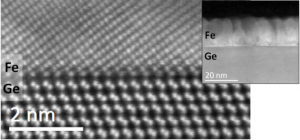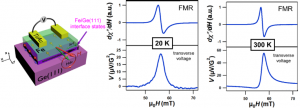We have demonstrated the spin-to-charge interconversion by Rashba coupling at the interface between two light materials: iron and germanium which is compatible with today’s CMOS technology. This result constitutes the first step towards the fabrication of a spin transistor based on the spin-orbit coupling.
The spin-orbit coupling, relating the electron spin and momentum, has long been neglected in the field of spintronics. Nowadays, the spin-orbit coupling is used to generate, detect and manipulate spins. It thus fulfils the three basic functions of the spin-field-effect-transistor that operates on the electron spin instead of its charge. For its fast integration to microelectronics, this spin-FET should be best developed into silicon or germanium which are materials compatible with today’s mainstream technology. In bulk materials, spin generation and detection is achieved through the spin-orbit coupling related phenomenon called the spin Hall effect. However, it is too weak in bulk silicon and germanium whereas large Rashba effect at Si(111) or Ge(111) surfaces covered with metals could efficiently generate and detect spin polarized currents. The Rashba spin splitting can actually be as large as hundreds of meV.
In this work, we show a giant spin-to-charge conversion in metallic states at the Fe/Ge(111) interface due to the Rashba coupling. We generate very large charge currents by direct spin pumping into the interface states from 20 K to room temperature. The presence of these metallic states at the Fe/Ge(111) interface is demonstrated by first-principles electronic structure calculations. By this, we demonstrate how to take advantage of the spin-orbit coupling at interfaces for the development of the spin-field-effect-transistor.

Figure 1: Transmission electron microscopy image of the Fe/Ge(111) interface
As shown in Figure 1, high-quality Fe/Ge(111) interfaces were prepared by molecular beam epitaxy with the epitaxial relationship Fe(111)[112 ̅]||Ge(111)[21 ̅1 ̅].
The sample as depicted in Figure 2 is then introduced into an X-band electron paramagnetic resonance cavity working at 9 GHz. hrf and Hdc are the radiofrequency and static applied magnetic fields respectively. At the Fe ferromagnetic resonance, we dynamically produce a spin accumulation into the Fe/Ge interface states by spin pumping. This spin accumulation is converted into a transverse 2D charge current by the Rashba spin-orbit coupling (figure 2).

Figure 2: sketch of the measurement geometry for spin pumping. FMR/transverse voltage measurements performed at 20 K and 300 K respectively.
We could measure charge currents up to 1 µA for a radiofrequency power of 200 mW and independent on the temperature. The interfacial spin-to-charge conversion is further supported by the fact that the Ge substrate and the Fe/Ge interface become electrically insulating when decreasing the temperature. Finally, the existence of such Fe/Ge(111) metallic Rashba states was demonstrated by ab initio calculations and the Rashba spin splitting can reach 50 meV close to the K points of the surface Brillouin zone. In conclusion, we have experimentally and theoretically shown giant spin-to-charge conversion at the interface between two light atoms, one of them being germanium which is compatible with silicon-based technology. This work suggests that spin currents can be generated from charge currents at the single-crystalline Fe/Ge(111) interface which constitutes the first brick of a spin-orbit coupling based spin-FET.
Reference : S. Oyarzún, A. K. Nandy, F. Rortais, J.-C. Rojas-Sánchez, M.-T. Dau, P. Noël, P. Laczkowski, S. Pouget, H. Okuno, L. Vila, C. Vergnaud, C. Beigné, A. Marty, J.-P. Attané, S. Gambarelli, J.-M. George, H. Jaffrès, S. Blügel & M. Jamet, Nature Comm. 7, 13857 (2016).
Collaborators:
– Unité Mixte CNRS/Thales, Palaiseau, France.
– Forschungszentrum, Juelich, Germany.
– Electron microscopy performed at the PFNC, CEA Grenoble




